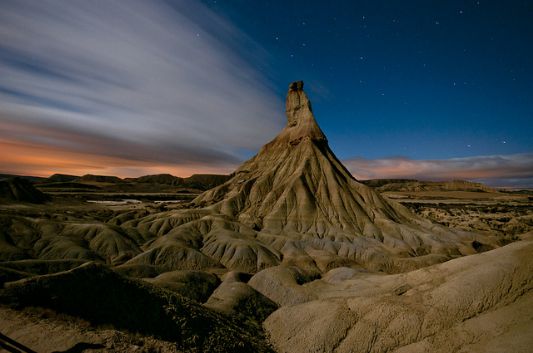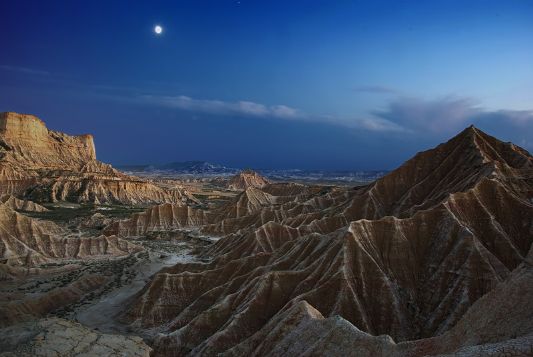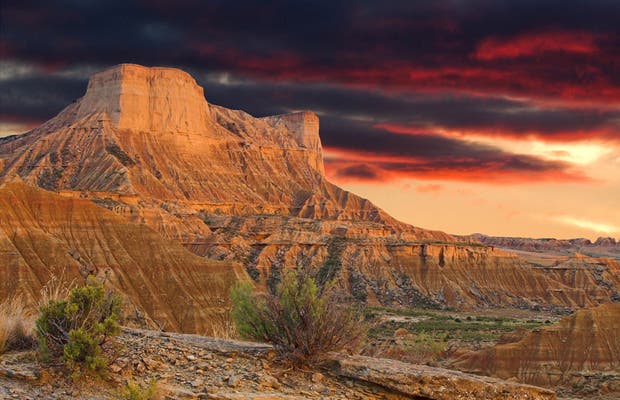Who would ever have thought that this landscape could be found in Northern Spain, A land of green pastures, valleys, vineyards, lakes and mountains? A terrain more akin to the wild west or a scene with Peter O’Toole blazing his way to glory in the “Arabian” desert of Almeria. But this wonderfully mysterious land is just 70km from the ski slopes of the Pyrenees and holds the title of the largest desert in mainland Europe.
Bardenas Reales Natural Park is a place of wild beauty declared a Biosphere Reserve by the United Nations. It is a semi-desert landscape covering 42.500 hectares that is breathtaking and surprises anyone who might cast their eyes over it. A surreal spectacle in southeast Navarre, despite its bare and inhospitable appearance, is an oasis of natural assets.
The erosion of its clay, chalk and sandstone soils has sculpted capricious forms in the landscape to create almost lunar effects, full of gullies, plateaux and solitary hills. It has inspired painters and writers and has been the scene of TV adverts, music videos and films. A unique setting that seems out of place in Northern Spain and leaves nobody indifferent. You can visit this barren land on foot, by bicycle, on horseback or even with 4X4 motor vehicles. Specialist guides are available to help you to discover unforgettable spots with echoes of legends such as the famous highwayman Sanchicorrota, who used to fool his pursuers by putting his horse's shoes on backwards so they couldn’t follow him!

Bardenas Reales is a landscape sculpted over millions of years due to erosion. There are three distinct zones in the natural park which are, from north to south: El Plano, croplands characterised by very gentle slopes; the Bardena Blanca, the most photographed and visited area, where the main rock formations can be found in Castildetierra and Pisquerra. Also in this area, defined by its eroded crags, dry gullies and steppe-like appearance - in its lower part is a Firing Range used by the US Military, which explains the fighter planes; and the Bardena Negra, where the land darkens, giving way to the only Aleppo pinewoods in the area, accompanied by thicket.

Exceptional viewpoints show the differences between its different zones. From the Alto de Aguilares, you get the best panoramic view of the Bardena Blanca. The Balcón de Pilatos ('Pontius Pilate's Balcony') is an exceptional observatory of birds of prey. These high points show the wealth of this territory, which contain three Nature Reserves: the Vedado de Eguaras, an oasis to the north of the area where the ruins of the Castle of Peñaflor still stand; the Rincón del Bu (in Bardena Blanca), occupying 460 hectares, where the eagle owl breeds; and the Nature Reserve of Caídas de la Negra (in Bardena Negra), which covers 1,926 hectares and has altitude drops of 270 metres.


The Bardenas Reales Natural Park also offers more than 700 kilometres of paths, tracks and gullies that can be followed by hiking and cycling enthusiasts. Nevertheless, it is advisable to use specialist guides in your first incursion into the natural enclave. Apart from avoiding the risk of getting lost in the desert, they will help you to interpret the landscape with a flora and fauna more appropriate to an African desert than the north of the Iberian Peninsula. In the remote past, it was even inhabited by crocodiles and turtles. Eagles, vultures, owls, great bustards, foxes, mountain cats, genets, amphibians and reptiles range between scrubland, sisal thickets, salt marshes and reed beds.
Due to the extreme temperatures and the special conditions of the land, it is recommended that one avoids going when it is raining. The best time to visit Bardenas is between September and June. On 18 September, if you have the opportunity go to the "Sanmiguelada", the day when thousands and thousands of sheep from the Pyrenean valleys make their way to this vast extension along El Paso to graze during the winter. To do this, follow the Cañada Real (royal livestock trail) of the Roncaleses which links up the pastures of the Roncal Valley with the Bardenas.
Places like this are what makes Spain such a special country. One could even consider Spain to be a small continent as it offers almost every terrain you could possibly imagine, the choice and wealth of nature is far beyond
what most people can even imagine, but wander away from the coastline and you can discover a world that will leave its mark forever.
Ver mapa más grande